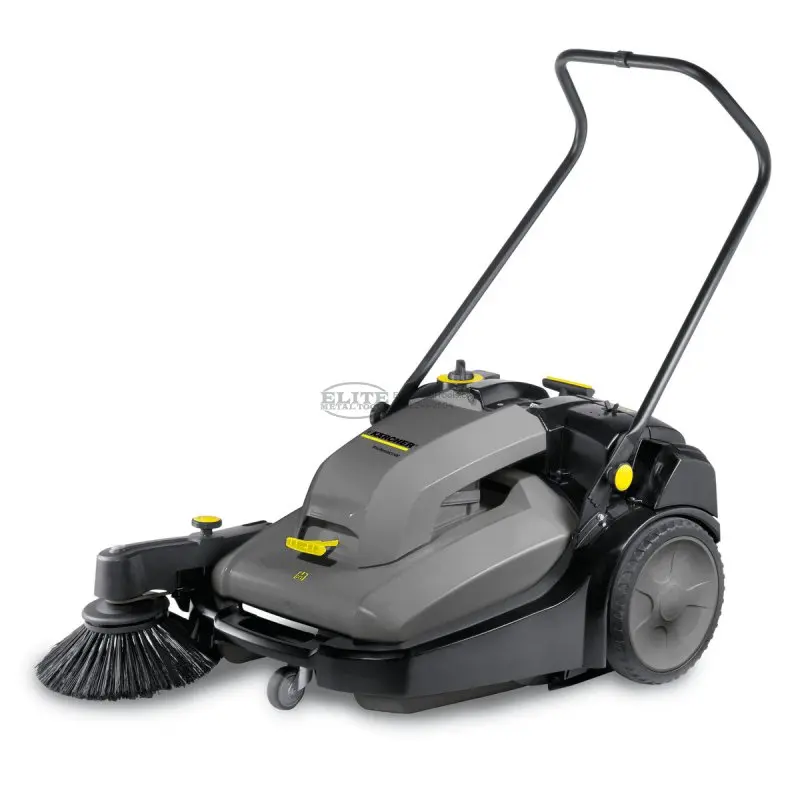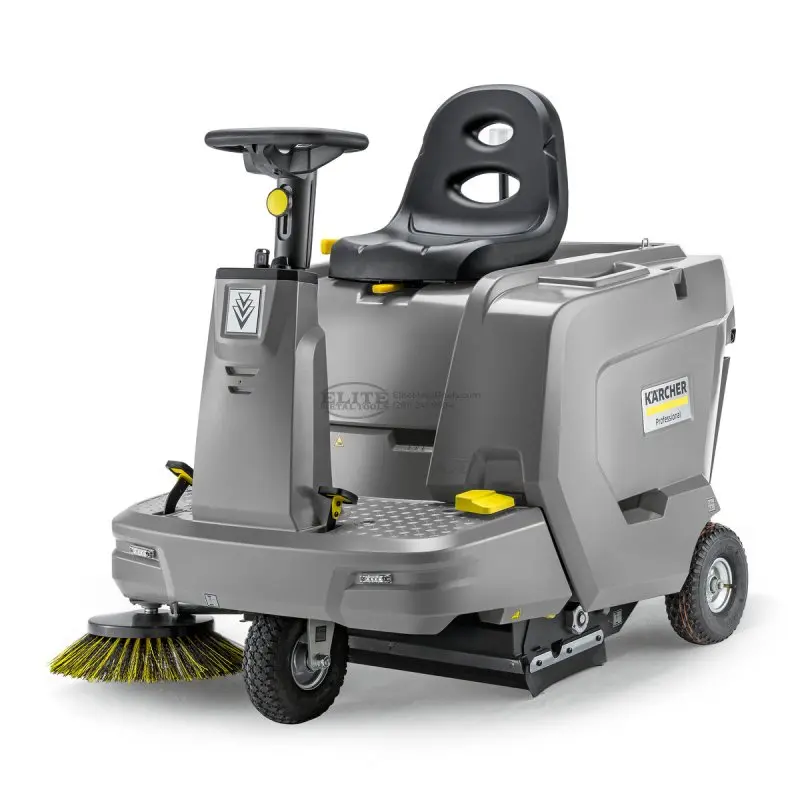Elite Metal Tools Articles
Industry news, tips, and updates on all things Elite Metal Tools
Sweepers - Let's Learn About
The Evolution and Advantages of Powered Sweepers: A Comprehensive Guide
Introduction
Sweepers have played a crucial role in maintaining clean and debris-free environments for centuries. As technology has advanced, so have these indispensable cleaning tools. In this comprehensive guide, we will explore the history of sweepers, the advantages of modern powered sweepers, and their diverse applications in various industries. Additionally, we'll delve into the contributions of industry-leading brands like Karcher, renowned for their innovative approach to cleaning solutions.
History of Sweepers
The concept of sweepers dates back to ancient times when brooms made from natural materials were used to clean floors and streets. As civilizations progressed, manual sweepers with rotating brushes emerged, making cleaning more efficient. In the 19th century, horse-drawn mechanical sweepers paved the way for modern motorized sweepers. It wasn't until the mid-20th century that motorized walk-behind sweepers became prevalent, revolutionizing the cleaning industry.
Types of Sweepers
Today, powered sweepers come in various forms to cater to diverse cleaning needs:
-
Ride-On Sweepers: Ride-on sweepers are ideal for large-scale cleaning tasks. They offer high-capacity debris collection and are designed for operator comfort and efficiency. These sweepers are commonly used in vast industrial facilities and outdoor spaces like parking lots and airports.
-
Walk-Behind Sweepers: Walk-behind sweepers provide excellent maneuverability, making them suitable for smaller spaces, indoor cleaning, and congested areas. They are often preferred for commercial spaces, schools, and retail environments./product/17762
-
Industrial Floor Sweepers: Industrial floor sweepers are heavy-duty machines designed to tackle tough cleaning challenges in warehouses and manufacturing facilities. They offer robust dust and debris collection capabilities.
-
Street Sweepers: Street sweepers are designed to clean urban roads, highways, and public spaces. They help improve the overall cleanliness of cities while reducing environmental pollution.
-
Vacuum Sweepers: Vacuum sweepers utilize powerful suction to efficiently clean various surfaces. They are particularly effective in removing fine dust and debris from both indoor and outdoor areas.
-
Rotary Sweepers: Rotary sweepers use spinning brushes to collect debris and are often used for outdoor applications. They are popular for maintaining sidewalks, walkways, and other paved surfaces.
Advantages of Powered Sweepers
Powered sweepers offer several key advantages over manual cleaning methods:
-
Increased Efficiency and Productivity: Powered sweepers cover larger areas in less time, boosting cleaning efficiency and reducing labor costs.
-
Cost-Effectiveness: While the initial investment may be higher, the long-term cost savings due to reduced labor and improved cleaning performance make powered sweepers a cost-effective choice.
-
Environmental Benefits: Many modern sweepers are designed to be eco-friendly, with features such as water recycling and low emissions, reducing their environmental impact.
-
Versatility in Various Environments: Powered sweepers are versatile and can handle different surfaces, including concrete, asphalt, tile, and carpets, making them suitable for a wide range of applications.
Considerations When Choosing a Sweeper
Selecting the right sweeper for specific cleaning needs requires careful consideration:
-
Surface Type and Size: Consider the type and size of the surfaces that need cleaning to choose a sweeper with the appropriate features and capacity.
-
Indoor vs. Outdoor Applications: Determine whether the sweeper will be used predominantly indoors or outdoors, as this can impact the choice of power source and maneuverability.
-
Cleaning Capacity and Speed: Evaluate the cleaning capacity and speed of the sweeper to ensure it matches the required cleaning demands.
-
Maneuverability and Ergonomics: For areas with tight spaces, a highly maneuverable sweeper with ergonomic design features can improve efficiency.
-
Maintenance and Serviceability: Look for sweepers with easy maintenance and service requirements to minimize downtime and ensure optimal performance.
The Evolution of Sweeper Technology
The evolution of sweepers has been driven by technological advancements:
-
Early Manual Sweepers: Ancient brooms evolved into manual sweepers with rotating brushes, improving cleaning efficiency.
-
Introduction of Motorized Sweepers: The introduction of motorized sweepers in the 19th century increased cleaning capabilities and reduced manual labor.
-
Advancements in Brush Technology: Modern sweepers utilize advanced brush technology, including adjustable brush pressure and brush configurations tailored for specific cleaning tasks.
-
Automation and Robotics in Modern Sweepers: Recent developments have seen the integration of automation and robotics, allowing for autonomous cleaning operations in controlled environments.
How Sweepers Contribute to a Cleaner Environment
Powered sweepers play a significant role in environmental preservation:
-
Dust and Pollution Reduction: Sweepers effectively collect dust and debris, contributing to cleaner air quality and reducing respiratory issues caused by airborne particles.
-
Removal of Debris and Litter: By removing litter and debris from streets and public areas, sweepers prevent pollution and maintain a cleaner environment.
-
Preventing Contaminants from Entering Waterways: Street sweepers help prevent pollutants from entering storm drains, safeguarding waterways and aquatic ecosystems.
Applications of Powered Sweepers
Powered sweepers find applications in various industries:
-
Municipal Cleaning and Street Sweeping: Municipalities use sweepers to maintain public spaces, roads, and sidewalks, enhancing the overall cleanliness and appearance of the city.
-
Warehouses and Industrial Facilities: Industrial floor sweepers play a crucial role in keeping warehouses and manufacturing facilities clean and safe for employees and equipment.
-
Airports and Parking Lots: Ride-on sweepers efficiently manage the cleaning demands of airports and parking lots, where vast areas require regular maintenance.
-
Shopping Centers and Malls: Walk-behind sweepers are suitable for cleaning indoor spaces, such as shopping centers and malls, ensuring a pleasant shopping environment for visitors.
-
Educational Institutions: Sweepers help educational institutions maintain clean and safe campuses for students and staff.
Maintaining and Extending Sweeper Lifespan
Proper maintenance is essential to extend the lifespan of powered sweepers:
-
Regular Cleaning and Inspection: Regularly clean and inspect sweepers to identify and address potential issues before they escalate.
-
Replacing Worn Parts and Brushes: Timely replacement of worn-out parts and brushes ensures optimal cleaning performance.
-
Proper Battery Maintenance (for electric sweepers): For electric sweepers, follow battery maintenance guidelines to prolong their lifespan and runtime.
-
Professional Servicing and Repairs: Engage with qualified technicians for professional servicing and repairs to keep sweepers in top working condition.
Comparing Manual and Powered Sweepers
Comparing the advantages of manual and powered sweepers:
-
Efficiency and Cleaning Performance: Powered sweepers offer superior cleaning performance, covering more ground in less time compared to manual methods.
-
Labor Costs and Time Savings: Powered sweepers require fewer labor hours, leading to cost savings over manual cleaning methods.
-
Environmental Impact: Powered sweepers equipped with eco-friendly features help reduce the overall environmental impact compared to manual sweeping.
-
Long-Term Investment: While the initial cost of powered sweepers may be higher, their long-term benefits and durability make them a worthwhile investment.
Sweeper Industry Trends and Innovations
The sweeper industry is continuously evolving with cutting-edge advancements:
-
Integration of AI and Smart Technologies: AI-powered sweepers are becoming more prevalent, offering enhanced cleaning efficiency and automation.
-
GPS Tracking and Fleet Management: GPS integration allows for real-time tracking of sweepers, optimizing their routes and scheduling.
-
Emission Reduction and Energy Efficiency: Brands like Karcher are leading the way in developing eco-friendly sweepers that minimize emissions and energy consumption.
-
Sustainability Initiatives: Manufacturers are increasingly adopting sustainable practices, such as using recycled materials in the production of sweepers.
The Karcher Brand in the Sweeper Industry
As a prominent player in the cleaning solutions market, Karcher is synonymous with innovation and reliability. With a legacy spanning decades, Karcher has consistently introduced cutting-edge technology and environmentally friendly solutions in the sweeping industry. Their range of ride-on and walk-behind sweepers caters to various industries, providing efficient and sustainable cleaning solutions./product/17770
Conclusion
Powered sweepers have come a long way from the ancient brooms of old. With their efficiency, versatility, and positive impact on the environment, they have transformed the cleaning industry. Whether it's a ride-on sweeper maintaining an airport or a walk-behind sweeper tidying up a shopping mall, these machines play an essential role in keeping our surroundings clean and safe. With continuous advancements driven by leading brands like Karcher, the future of sweepers promises even greater efficiency and sustainability in the pursuit of a cleaner world.

